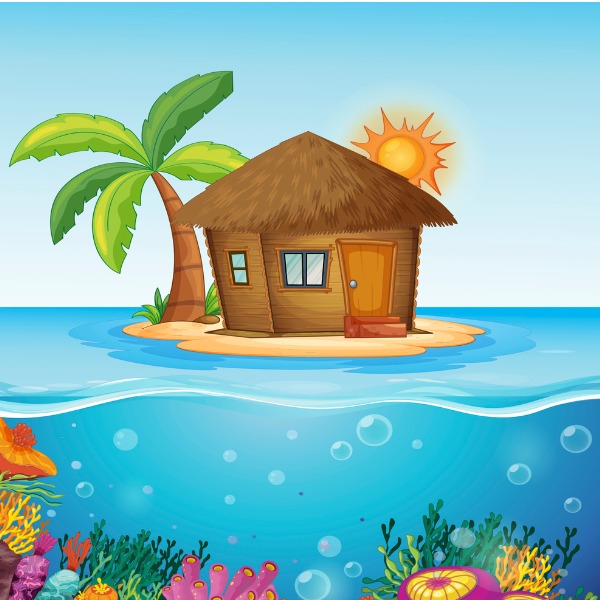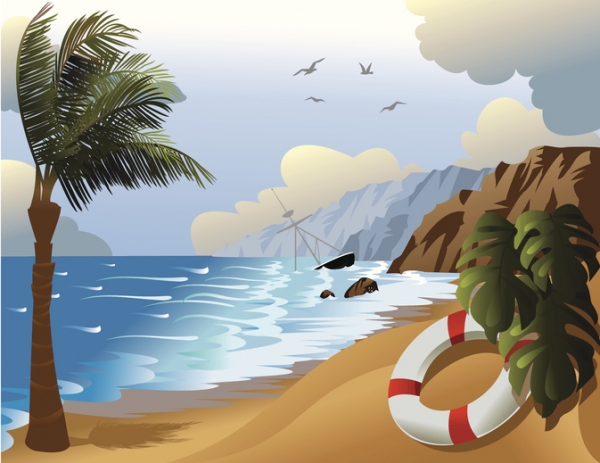How can we build a structure that protects toy people from wind?

Hut on a tiny island (colematt, iStockphoto)

Hut on a tiny island (colematt, iStockphoto)
How does this align with my curriculum?
How could you design and build a structure that protects toy people from the wind?
Consider using the Design & Build Process with this challenge.
This activity will help build skills related to the Plan, Create, Create, Test & Evaluate, and Reflect & Share phases of this process. It also highlights the iteration needed during this process.
What You Need
- Two small toy people, approx. 5 cm (2”) tall (e.g., LEGO® people)
- Craft sticks
- String
- Paper
- One small piece of stick tack (about the size of your fingernail) or tape
- One piece of cardboard
- Scissors
- One electric fan
What To Do
- Two toy people have been shipwrecked on a tropical island. Your challenge is to design and build a shelter for them. It needs to stand up to the wind from an electric fan.
Image - Text Version
Shown is a colour illustration of a beach with a palm tree and a life preserver. The leaves of the palm tree are bent in the wind. The sea looks rough, with white capped waves. The mast of a ship is visible, half-submerged in the water in the distance. There are tall cliffs around the beach, and a few grey clouds in the sky above. Part of the sky is clear and blue, with a few seagulls.
- Plan – Create drawings for what you want your structure to look like. Think about how moving air will affect the different materials and how you attach them together. There are several criteria for the design. Your plan must include these.
- The cardboard is the base.
- You must attach your structure to the cardboard using the stick tack or tape. You cannot use the stick tack or tape for anything else.
- The toy people must be able to fit inside the structure.
- Create - Build a prototype. This is a working model that you will be able to test. You can only use materials from the materials list.
- Test - When you are satisfied with your prototype, it is time to test it!
- Place the structure 60 cm (~2’) away from the electric fan. Point the fan at the structure.
- Turn the fan on its lowest setting for 30 seconds.
- Evaluate – How well did the structure stand up to the wind?
- If your structure withstands the lowest setting, turn the fan up to the next setting for 30 seconds. Continue until the fan is at its maximum setting.
- If your structure failed before reaching the maximum setting, think about which parts failed. Go back to your design. How can you make it better?
- If you have time, keep trying. See if you can make the structure strong enough so the toy people remain inside, and it does not fall apart when blown by the fan at the highest setting for at least 30 seconds.
- Reflect & Share – How well did you do? What would you do differently next time? Would this design work in real life? Why or why not?
Discovery
It is important to think about the climate and environmental conditions of a region when designing structures. Important things to consider include wind, temperature and precipitation patterns. Knowing the chance of extreme weather events, such as floods and hurricanes, is also important.
Wind happens when air flows from an area of high pressure to an area of low pressure. Tropical islands can have very strong winds during hurricanes. Hurricanes form when warm, moist air over the ocean rises quickly. This creates an area of low pressure. Then, air blows into this area of low pressure. This new air gets warmer and rises as well. This cycle can lead to violent winds that can batter islands and coastal areas.
For this activity, you created a model of a structure on a tropical island. Your materials were limited to materials or objects like what you might find there. For example, you might be able to use wood from trees. That’s why you had wooden craft sticks. You also might be able to braid rope from leaves or grasses. This is why you had string.
While many regions experience regular extreme weather events, climate change is making these events more severe and more frequent. Some parts of the world that rarely experience extreme weather are now experiencing it more often and more intensely. Structures are not always designed for extreme weather, which can cause them to fail. One way that people can adapt to climate change is to make sure that the structures they design are ready for extreme weather.
Image - Text Version
Shown is a colour aerial photograph of a row of houses surrounded by water. The lower half of the image is filled with rough, grey water with lots of white caps. Above, a neat row of houses indicates this is a street. There is no grass or pavement visible around the houses. They sit in dark grey water. The trees in their front and back yards are half-submerged.
- If you are doing this with other teams, compare your designs. Was there anything in common between the successful designs? What about designs that failed?
- Can your structure withstand the wind from all directions? Rotate your structure so that each side is exposed to the wind. How would you change your design to make this better?
- What if it started raining? How would you change your design to protect your toy people from water as well?
- If you could use any other materials that weren’t listed in this activity, which ones would you choose and why?
Weather: Wind (2020)
This backgrounder from Let’s Talk Science explains what causes wind and how to measure it.
Where Do Hurricanes Come From? (2019)
This article from Let’s Talk Science explains how hurricanes form, where they hit land and the damage they can do.
How Do Hurricanes Form? (2019)
This video (2:22 min) from NOAA SciJinks illustrates how hurricanes start and how we know they’re coming.
Doug White Architecture. (n. d.). Design Guidelines for Hurricane Resistant Buildings.
NASA Science. (2019). How Do Hurricanes Form?
New Jersey Institute of Technology. (2007). Home Shapes And Roofs That Hold Up Best In Hurricanes. Science Daily.
UCAR Center for Science Education. (n. d.) Hurricane Damage.
What’s Happening?
It is important to think about the climate and environmental conditions of a region when designing structures. Important things to consider include wind, temperature and precipitation patterns. Knowing the chance of extreme weather events, such as floods and hurricanes, is also important.
Wind happens when air flows from an area of high pressure to an area of low pressure. Tropical islands can have very strong winds during hurricanes. Hurricanes form when warm, moist air over the ocean rises quickly. This creates an area of low pressure. Then, air blows into this area of low pressure. This new air gets warmer and rises as well. This cycle can lead to violent winds that can batter islands and coastal areas.
For this activity, you created a model of a structure on a tropical island. Your materials were limited to materials or objects like what you might find there. For example, you might be able to use wood from trees. That’s why you had wooden craft sticks. You also might be able to braid rope from leaves or grasses. This is why you had string.
Why does it matter?
While many regions experience regular extreme weather events, climate change is making these events more severe and more frequent. Some parts of the world that rarely experience extreme weather are now experiencing it more often and more intensely. Structures are not always designed for extreme weather, which can cause them to fail. One way that people can adapt to climate change is to make sure that the structures they design are ready for extreme weather.
Image - Text Version
Shown is a colour aerial photograph of a row of houses surrounded by water. The lower half of the image is filled with rough, grey water with lots of white caps. Above, a neat row of houses indicates this is a street. There is no grass or pavement visible around the houses. They sit in dark grey water. The trees in their front and back yards are half-submerged.
Investigate Further
- If you are doing this with other teams, compare your designs. Was there anything in common between the successful designs? What about designs that failed?
- Can your structure withstand the wind from all directions? Rotate your structure so that each side is exposed to the wind. How would you change your design to make this better?
- What if it started raining? How would you change your design to protect your toy people from water as well?
- If you could use any other materials that weren’t listed in this activity, which ones would you choose and why?
Learn More
Weather: Wind (2020)
This backgrounder from Let’s Talk Science explains what causes wind and how to measure it.
Where Do Hurricanes Come From? (2019)
This article from Let’s Talk Science explains how hurricanes form, where they hit land and the damage they can do.
How Do Hurricanes Form? (2019)
This video (2:22 min) from NOAA SciJinks illustrates how hurricanes start and how we know they’re coming.
References
Doug White Architecture. (n. d.). Design Guidelines for Hurricane Resistant Buildings.
NASA Science. (2019). How Do Hurricanes Form?
New Jersey Institute of Technology. (2007). Home Shapes And Roofs That Hold Up Best In Hurricanes. Science Daily.
UCAR Center for Science Education. (n. d.) Hurricane Damage.

